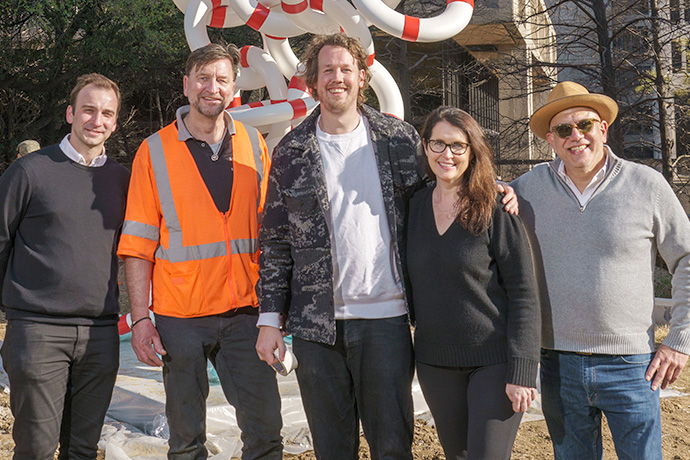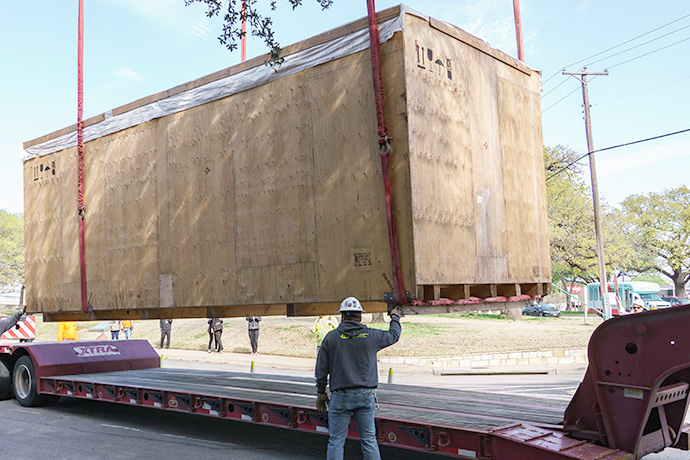One UT Southwestern treasure bestows another

It was a red-letter day – or perhaps a red-striped one – when the fifth sculpture in UT Southwestern’s growing outdoor art collection donated by a Nobel Laureate was placed outside the Eugene McDermott Academic Administration Building.
Life Rings, Fig. 2, by the German artistic team of Elmgreen & Dragset, was acquired with funds donated by Joseph Goldstein, M.D., Chair of Molecular Genetics. It features more than three dozen interlinked red-and-white striped life preservers stretching skyward in a strong yet precarious-looking arrangement.
The work, located near the South Campus entrance to the University, marks the fifth piece of outdoor art Dr. Goldstein has donated. The earlier gifts, all on the adjacent Dr. Donald Seldin Plaza, include a massive organic assemblage called Dumna by Ursula von Rydingsvard and three untitled works: two angular, metallic works by New York sculptor Joel Shapiro, and a large bronze and copper-plated steel construction by Christopher Wool that was inspired by tangled fencing wire in West Texas.
Dr. Goldstein and fellow Nobel Laureate Michael Brown, M.D., who run a joint laboratory, have mentored dozens of students and postdoctoral researchers who have become leaders themselves at UTSW and in laboratories worldwide. The duo won the 1985 Nobel Prize in Physiology or Medicine for identifying the low-density lipoprotein (LDL) receptor, laying the conceptual foundation for the lifesaving statin class of cholesterol-lowering drugs.

“Life Rings, Fig. 2 is a wonderful addition to campus, providing a welcome to visitors and reminding our faculty, staff, students, and patients of the University’s dedication to our deeper mission, preserving life through discovery, innovation, and exceptional patient care,” said UT Southwestern President Daniel K. Podolsky, M.D. “We are extremely grateful to Dr. Goldstein whose work, together with Dr. Brown, has set the standard of excellence for science at UT Southwestern for decades and whose generosity has enhanced our campus with this sculpture to inspire all who come to UT Southwestern, whether to work, learn, or visit.”
During his travels, Dr. Goldstein often brings back posters from art museums and galleries he tours. He shares those images with trainees by mounting them in the corridors outside the Brown-Goldstein lab. Nearby is a chart covering an entire wall that lists the many scientists the researchers have mentored during their 50-year partnership. Those displays reflect Dr. Goldstein’s passions: science, teaching, and art.
Among his many legacies, Dr. Goldstein is known for his annual essays on The Art of Science used to announce recipients of the prestigious Lasker Medical Research Award during his nearly 20 years as chair of the prize jury (2001-2019). Drs. Brown and Goldstein won that award in 1985, too.
“Elmgreen & Dragset are among the most creative and provocative sculptors in the world today. They have created over 100 large public sculptures that juxtapose familiar objects in unfamiliar settings. Their work is full of wit and surprises, which stimulate us to think in new ways,” Dr. Goldstein said.
“I first became familiar with the artists about 15 years ago when they erected the sculpture Prada Marfa in the West Texas desert near the small town of Marfa. Prada Marfa, which emulates the style and display of a Prada luxury boutique, has never been open for business and has become a pilgrimage for thousands of fashion fans, many of whom are oblivious to the artists’ mockery of consumerist culture,” he added.

Life Rings, Fig. 2, which stands nearly 25 feet tall, is a quintessential example of their artistic technique, he said.
“Typical of their sense of humor, the life belts are constructed out of metal (stainless steel), which definitely will not help someone in distress. Life Rings reminds me not only of life preservers but also of Life Savers hard candy,” he said.
The installation took months of planning and coordination across teams from the University, the artists’ studio and fabricator in Germany, local engineers, and the contractor, explained UTSW Art Curator Courtney Crothers, who said that the addition of Life Rings, Fig. 2 to campus makes sense. “It’s a wonderful reminder of our mission to heal,” she said.
All sculptures that Dr. Goldstein funded were chosen in consultation with art consultant Talley Dunn, whom the researcher first worked with in the early 1990s when she was beginning her art career at another Dallas gallery before opening the Talley Dunn Gallery. She described the collaborative process as she assisted Dr. Goldstein in choosing the art, then worked with him and a large UTSW team on placing the pieces to best complement the natural beauty of the campus.
“Each sculpture invites the viewer to experience the work from countless vantage points when walking through the area. We’re hoping that these ever-changing experiences encourage people to engage with these dynamic works of art throughout the day, spending more time outside on campus, whether to visit with colleagues or have lunch,” Ms. Dunn said.
“These sculptures create wonderful outdoor spaces to be enjoyed, and we all think about the value of spending more time outdoors now,” she added, referring to the ongoing COVID-19 pandemic.
After fabrication at a foundry near Berlin, Germany, the 11-ton artwork required shipping by boat due to its weight. When it arrived at the port of Galveston, Texas, the massive crate containing the structure was loaded on a large flatbed truck for the 290-mile drive to Dallas, Ms. Crothers said.

Meanwhile, UTSW Senior Construction Manager Jake Roysdon oversaw the creation of a strong foundation to precise specifications to support the creation, which is viewable from the below-ground outdoor patio of the South Campus food court nearby.
“It’s a big deal, something you get to be a part of that’s going to be here for a long time,” Mr. Roysdon said as the enormous creation was carefully lowered into place.
Although the artistic team of Michael Elmgreen and Ingar Dragset was busy at another installation in Europe when Life Rings, Fig. 2 was set up in Dallas, staff from the artists’ studio, their foundry near Berlin, and their U.S. gallery all assisted in the daylong event.
Dr. Goldstein encouraged viewers to make their own interpretations of the art.
“What makes a sculpture a great piece of art is the power to stimulate different reactions in different people,” Dr. Goldstein said. “Some will perceive the rings as holding each other together, symbolizing cooperation and security in crisis situations. Others might perceive the rings as trying to break free from each other, symbolizing the desire for individuality.”
Whatever the viewers’ perspectives, their likely takeaway will be to see the statue and its benefactor as University treasures.
Dr. Brown, a Regental Professor, is Director of the Erik Jonsson Center for Research in Molecular Genetics and Human Disease and a Professor of Molecular Genetics and Internal Medicine. He holds The W.A. (Monty) Moncrief Distinguished Chair in Cholesterol and Arteriosclerosis Research, and the Paul J. Thomas Chair in Medicine.
Dr. Goldstein, a Regental Professor, holds the Julie and Louis A. Beecherl, Jr. Distinguished Chair in Biomedical Research, and the Paul J. Thomas Chair in Medicine.
Dr. Podolsky holds the Philip O’Bryan Montgomery, Jr., M.D. Distinguished Presidential Chair in Academic Administration, and the Doris and Bryan Wildenthal Distinguished Chair in Medical Science.

